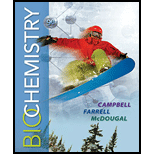
Concept explainers
MATHEMATICAL Using the information in Table 20.2, calculate
Interpretation:
The standard free energy change for the given biological reaction is to be determined.
Concept introduction:
Oxidation is the addition of an electronegative element or the removal of an electropositive element in a chemical reaction.
Reduction is the addition of an electropositive element or the removal of an electronegative element in a chemical reaction
The chemical reaction in which oxidation process and reduction process takes place and reduction take place simultaneously is called a redox reaction.
The relation between standard free energy change and standard reduction potential for the biological process is shown as follows:
Here,
Answer to Problem 8RE
Solution:
Explanation of Solution
The half reactions that are paired during the redox reaction are shown below, along with their standard free energy change:
The aim reaction for which the standard free energy is to be calculated is shown as follows:
As, the aim reaction can be calculated as follows:
Therefore the standard free energy is calculated as follows:
Hence, the standard free energy of the given biological reaction will be calculated.
The standard free energy of the given biological reaction is
Want to see more full solutions like this?
Chapter 20 Solutions
Biochemistry
- REFLECT AND APPLY A model is proposed to explain the reaction catalyzed by an enzyme. Experimentally obtained rate data fit the model to within experimental error. Do these findings prove the model?arrow_forwardREFLECT AND APPLY What is the relationship between a transition-state analog and the induced-fit model of enzyme kinetics?arrow_forwardREFLECT AND APPLY What are some of the difficulties in determining the exact number of protons pumped across the inner mitochondrial membrane by the respiratory complexes?arrow_forward
- REFLECT AND APPLY Why is it important that energy released by exergonic reactions can be used to provide energy for endergonic reactions?arrow_forwardREFLECT AND APPLLY Is the reaction of 2-phosphoglycerate to phosphoenolpyruvate a redox reaction? Give the reason for your answer.arrow_forwardREFLECT AND APPLY Why is it useful to plot rate data for enzymatic reactions as a straight line rather than as a curve?arrow_forward
- REFLECT AND APPLY The following half reactions play important roles in metabolism. 1/2O2+2H++2eH2ONADH+H+NAD++2H++2e Which of these two is a half reaction of oxidation? Which one is a half reaction of reduction? Write the equation for the overall re- action. Which reagent is the oxidizing agent (electron acceptor)? Which reagent is the reducing agent (electron donor)?arrow_forwardREFLECT AND APPLLY What are the metabolic effects of not being able to produce the M subunit of phosphofructokinase?arrow_forwardMATHEMATICAL For an enzyme that displays MichaelisMenten kinetics, what is the reaction velocity, V (as a percentage of Vmax), observed at the following values? (a) [S]=KM (b) [S]=0.5KM (c) [S]=0.1KM (d) [S]=2KM (e) [S]=10KMarrow_forward
- REFLECT AND APPLY What do the following indicators tell you about whether a reaction can proceed as written? (a) The standard free-energy change is positive. (b) The free-energy change is positive. (c) The reaction is exergonic.arrow_forwardREFLECT AND APPLY Show how the reactions of the electron transport chain differ from those in Question 3 when FADH2 is the starting point for electron transport. Show how the reactions that liberate enough energy to drive the phosphorylation of ADP differ from the pathway when NADH is the starting point.arrow_forwardMATHEMATICAL Consider the reaction AB+C, where G=0.00. (a) What is the value of G (not G) when the initial concentrations of A, B, and C are 1 M, 103M,and106M? (b) Try the same calculations for the reaction D+EF, for the same relative order of concentrations. (c) Try the same calculations for the reaction GH, if the concentrations are 1Mand103M for G and H, respectively.arrow_forward
 BiochemistryBiochemistryISBN:9781305961135Author:Mary K. Campbell, Shawn O. Farrell, Owen M. McDougalPublisher:Cengage Learning
BiochemistryBiochemistryISBN:9781305961135Author:Mary K. Campbell, Shawn O. Farrell, Owen M. McDougalPublisher:Cengage Learning
